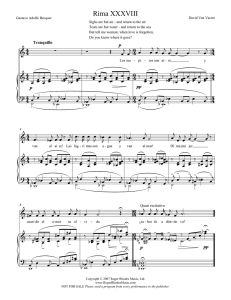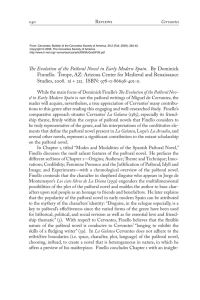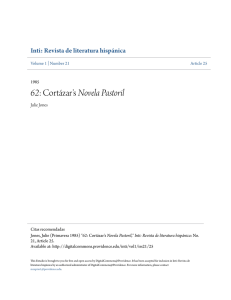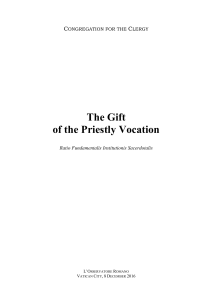“GAUDIUM ET SPES, LUCTUS ET ANGOR” VIRTUES
Anuncio
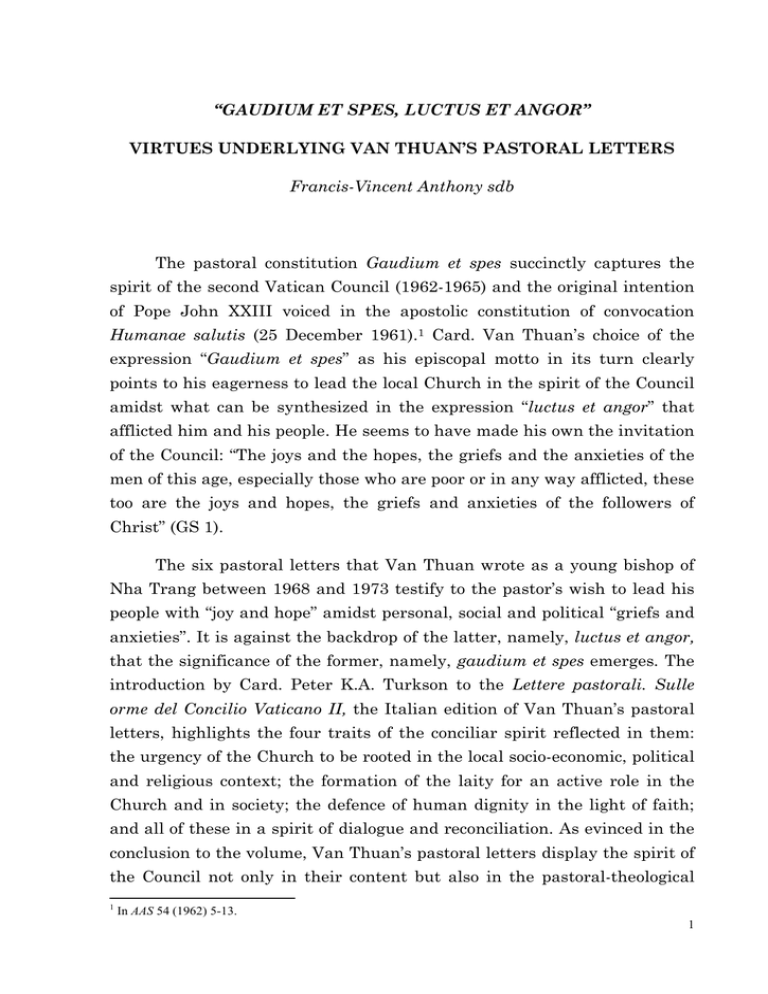
“GAUDIUM ET SPES, LUCTUS ET ANGOR” VIRTUES UNDERLYING VAN THUAN’S PASTORAL LETTERS Francis-Vincent Anthony sdb The pastoral constitution Gaudium et spes succinctly captures the spirit of the second Vatican Council (1962-1965) and the original intention of Pope John XXIII voiced in the apostolic constitution of convocation Humanae salutis (25 December 1961).1 Card. Van Thuan’s choice of the expression “Gaudium et spes” as his episcopal motto in its turn clearly points to his eagerness to lead the local Church in the spirit of the Council amidst what can be synthesized in the expression “luctus et angor” that afflicted him and his people. He seems to have made his own the invitation of the Council: “The joys and the hopes, the griefs and the anxieties of the men of this age, especially those who are poor or in any way afflicted, these too are the joys and hopes, the griefs and anxieties of the followers of Christ” (GS 1). The six pastoral letters that Van Thuan wrote as a young bishop of Nha Trang between 1968 and 1973 testify to the pastor’s wish to lead his people with “joy and hope” amidst personal, social and political “griefs and anxieties”. It is against the backdrop of the latter, namely, luctus et angor, that the significance of the former, namely, gaudium et spes emerges. The introduction by Card. Peter K.A. Turkson to the Lettere pastorali. Sulle orme del Concilio Vaticano II, the Italian edition of Van Thuan’s pastoral letters, highlights the four traits of the conciliar spirit reflected in them: the urgency of the Church to be rooted in the local socio-economic, political and religious context; the formation of the laity for an active role in the Church and in society; the defence of human dignity in the light of faith; and all of these in a spirit of dialogue and reconciliation. As evinced in the conclusion to the volume, Van Thuan’s pastoral letters display the spirit of the Council not only in their content but also in the pastoral-theological 1 In AAS 54 (1962) 5-13. 1 method of discerning the “signs of the time”, identifying the emerging challenges and urgencies, and evolving appropriate strategies of pastoral action. In the present reflection, therefore, we shall briefly trace the context of “griefs and anxieties” in which the young bishop sought to instil “joy and hope” among his people. These two expressions, namely, gaudium et spes and luctus et angor that respectively stand for profoundly Christian and human sentiments – as we shall see below – point to the virtues underlying the pastoral letters. Luctus et angor: the context of the pastoral letters2 The years in which the pastoral letters were written, namely, between 1968 and 1973, the waves of sociocultural and political upheaval that were on the rise for over two decades in Vietnam and in the rest of the world reached their zenith. The situation in the South Vietnam – after the division in 1954 – precipitated with the assassination of the President Ngo Dinh Diem, the maternal uncle of Van Than, during the coup of 1963. The violent offensive of Tet Mau Than (the Vietnamese New Year of 1968) that followed further deteriorated the situation in the various cities of the South, including Nha Trang, to which Van Thuan was nominated as bishop in 1967. It is in this context of personal and collective “griefs and anxieties” that the young bishop of Nha Trang wrote the first of his pastoral letters. The violent conflict continued to spread even after the death of Ho Chi Minh in 1969 as the bishop penned his second letter. The fierce attack launched by communist forces on Good Friday, 31 March 1972, concluded with the Peace Treaty of 1973 in Paris. Nevertheless, the consequent withdrawal of the last military unit of the USA on 29 March 1973 exposed South Vietnam to its tragic final fate. At this moment, Van Thuan headed one of the most vast humanitarian assistance (COREV – Cooperation for the Reconstruction of Vietnam) ever realized in the history of Vietnam. It was in this disastrous situation that 2 Cf. A. Nguyen VAN CHAU, Miracolo della Speranza. Il Cardinale François-Xavier Nguyen Van Thuan apostolo di pace, San Paolo, Cinisello Balsamo (MI) 2004, 154-221. 2 Van Thuan wrote his sixth and final pastoral letter. Paradoxically, his appointment on 23 April 1975 by Pope Paul VI as the Archbishop Coadjutor with rights of succession to the Archbishop of Saigon and simultaneously as titular Archbishop of Vadesi coincided with the new situation created by the annexation of the South Vietnam and with the beginning of his own “way of the cross” of thirteen years of imprisonment (1975-1988). It is against this backdrop of personal and collective “griefs and anxieties” – briefly evoked – that we need to grasp significance of the “joy and hope” that the pastoral letters of Van Thuan sought to instil among the faithful. Gaudium et spes: correlating Church and Society In his pastoral letters, reflecting the spirit of the Second Vatican Council, Van Thuan holds the two poles of Church and society in correlation, with the former having the task of bringing joy and hope to the latter. As the country plunged into civil war and violence, with the view to instilling hope, Van Thuan – in his first pastoral letter (1968) – invites the faithful to celebrate the First World Day of Peace (1 January 1968) launched by Pope Paul VI. Aware of the dangers that the country and the Church face, Van Thuan in his letter invites the people to “watch and pray”: to be wakeful in order to fulfil their duty as citizens and assume their responsibility in history. In the first place, he urges them to pay particular attention to family education, civil duties and socio-economic choices. As the political situation deteriorates – inspired by the Conciliar document Gaudium et spes – the pastor encourages the Christians to work for the common good, to fulfil their civil duties with integrity, and to resist the fascination for riches and comfort. As a second strategy for building up hope, he exhorts the faithful to pray, for in his view prayer is a way of being in solidarity with the world that faces endless problems. In prayer, 3 we can unite ourselves to God and bring God to humanity, and realize his will in this world. Launching the Movement of Justice and Peace in the diocese of Nha Trang, in his second pastoral letter (1969), Van Thuan gives expression to one of his cherished convictions, namely, that upholding human dignity in society is the foundation of justice and peace. The conflict situation in Vietnam and in other parts of the world requires that the faithful not only pray for peace, but also be constructors of peace by promoting justice, peace, and human rights. On the other hand, he also recommends the faithful – in the light of Vatican II – to grasp the mystery of the Church as the Body of Christ. Belonging to the Church and cultivating esteem for it would imply also respecting the ecclesiastical hierarchy. Taking up the same line of thought in the third pastoral letter (1970), Van Thuan underscores the responsibility and the duty of the laity in making the Church present in the contemporary world. It means that lay Christians are called to engage in a social revolution, taking up the promotion of integral development of every human person and of humanity as their proper vocation. Even while elaborating on the missionary nature of the Church and on the apostolic zeal of the laity on the occasion of the Year of Mission (1970) in Nha Trang – in the fourth pastoral letter – the young bishop does not lose sight of the integral development of the human person. Wanting to re-launch the zeal at the time of origins of the diocese of Nha Trang on its 300th anniversary, Van Thuan – in his fifth letter (1971) – underscores the outstanding witness of the Christian communities, namely, their fervour, courage and responsibility in the face of persecution, discrimination and death. Integrating the Vietnamese traditional democratic features, he proposes to promote the formation of parish councils in the diocese, with the view to building up the local Church. In the sixth letter (1973), dedicated to the Holy Year declared by Pope Paul VI, the young bishop focuses his attention on the central themes 4 of renewal and reconciliation, calling for prayer and collaboration of all priests, religious, young, and children in the renewal of the diocese. The six pastoral letters, each in its own way, seek to correlate the local Church and the local society, delineating the unique role of the former in transforming the latter. Here below we offer some examples. Although they are citizens of the Kingdom of heaven, the Catholics are not to forget that they are also citizens of this world. It means that attitudes of irresponsibility, indifference and egoism are serious errors against God and the country. Instead, Christians are to cultivate a sense of responsibility for the common good, taking up also some role in the political community (Pastoral Letter 1 = PL1). They are to be attentive to their duty as citizens, following the teachings of the Second Vatican Council (GS 40-43), according to which separating spiritual life from social life is a grave error of our time. The Church finds herself in the world, it lives with it and acts with it. It is like the yeast, the soul, for the human society (PL2). All and each of the Christians have the task of bringing the Church to the contemporary world. They must contribute to a social revolution, by working for the development of the whole person and the whole of humanity (PL3). Real Catholics are those who open their hearts to all persons, and consider them as brothers without making discrimination of class, color, religion and political opinion. The Catholics should make efforts to promote earthly development and, at the same time, permeate this development with the spirit of the Gospel (PL4). Virtues underlying the pastoral orientations for Christian action Given that the diocesan process for the beatification of Card. Van Thuan has already delved into his virtues, here we wish to trace some of them that emerge in the pastoral letters written by him to guide the local Church during the most turbulent period of its history. Pastoral letters are letters of a pastor deeply concerned about the Christian life of his own flock, his own diocese. As an instrument of animation of the local community in its pilgrimage of faith, pastoral letters 5 also serve the purpose of mediating the vision and orientations of the universal Church under the guidance of the Supreme Pontiff. The pastoral letters of the young bishop of Nha Trang reveal his keen intention to enlighten and guide the flock during the most tragic period of Vietnamese history, in the light of the Second Vatican Council’s innovative orientations with regard to Church’s role in the modern world. As an expression of a pastor’s concern for the people, these letters also reveal how much he himself was imbued with the spirit of the Council. Even more, they reveal the character and the virtues of the writer who possessed the art of expressing complex ideas in simple terms, making himself accessible to both the ordinary people and the elite. It is said that Van Thuan dedicated much time and energy in writing his letters to communicate to his flock what he really felt in his own heart.3 For these reasons, we can say that the pastoral orientations offered by Van Thuan in his letters give us an insight into the virtues that shaped his own pastoral and Christian actions, which perhaps find better expression in his later writings in prison and in exile. An overall analysis of his pastoral letters point to Van Thuan’s human and theological virtues. What do we mean by virtue here? As Catechism of the Catholic Church4 (assuming the Thomistic understanding) defines: “A virtue is an habitual and firm disposition to do the good. It allows the person not only to perform good acts, but to give the best of himself. The virtuous person tends toward the good with all his sensory and spiritual powers; he pursues the good and chooses it in concrete actions” (CCC 1803). Making a distinction between human and theological virtues, the CCC 1804 continues: “Human virtues are firm attitudes, stable dispositions, habitual perfections of intellect and will that govern our actions, order our passions, and guide our conduct according to reason and faith. They make possible ease, self-mastery, and joy in leading a morally good life”. 3 4 Cf. A. Nguyen VAN CHAU, Miracolo della Speranza, 197. See: http://www.vatican.va/archive/ENG0015/_INDEX.HTM (21-06-2013). 6 Insofar as they play a pivotal role, four human virtues are generally identified as cardinal virtues: prudence, justice, fortitude, and temperance (CCC 1805). The description of these virtues offered in the Catechism of the Catholic Church suggests that the writer of the pastoral letters was himself shaped by these virtues, as he wished to shape and guide the entire community along this path. In other words, the pastoral orientations of Van Thuan invite the Christian community to give expression to their faith in actions and choices inspired by these virtues. Here we see a clear interconnection between the pastoral action and the faith action of the community, sustained and inspired by the same set of cardinal virtues and above all theological virtues.5 Here below, we trace the references made to these virtues in the six pastoral letters. According to the CCC 1806, “Prudence is the virtue that disposes practical reason to discern our true good in every circumstance and to choose the right means of achieving it; … It is not to be confused with timidity or fear, nor with duplicity or dissimulation. … It is prudence that immediately guides the judgment of conscience.” As far as this virtue is concerned, it is significant that in the first pastoral letter (PL1), Van Thuan focusses on the theme: “Be prudent, stay wake and pray” (cf. 1 Pet 4, 7). Staying wake in order to see well entails that the Church should read the signs of the time and interpret them in the light of the Gospel (GS 4). In his view, Catholics need to be prudent; they should not work for peace in a simplistic or an excessively optimistic manner, for peace needs to be built on justice, freedom and respect for the rights of individuals and of communities (PL2). As described in the CCC 1807, “Justice is the moral virtue that consists in the constant and firm will to give their due to God and neighbour. Justice toward God is called the «virtue of religion». Justice toward men disposes one to respect the rights of each and to establish in human relationships the harmony that promotes equity with regard to persons and to the common good”. We may say that the virtue of justice 5 Cf. Julio Luis MARTÍNEZ, Virtudes, in Casiano Floristán (ed.), Nuevo diccionario de pastoral, San Pablo, Madrid 2002, 1586-1589. 7 had a special place of honour in Van Thuan’s life and writings. In his view, the church needs to act against injustice and oppression, and promote the rights of persons (PL1). The human person has right to life, to physical integrity, to means of survival and growth, to private property, to freedom, and to accomplish the goal set by God. Therefore reducing the human person to a productive collectivity, as viewed by communism, would be an error that needs to be challenged (PL2). The third pastoral letter focused specifically on the theme of “Justice and Peace”. Van Thuan was convinced that injustice has to be faced courageously with bold transformations and profound innovations (PL3). It calls the Catholics to the duty of solidarity, social justice, and integral development of the human person (PL4). According to the CCC 1808, “Fortitude is the moral virtue that ensures firmness in difficulties and constancy in the pursuit of the good. It strengthens the resolve to resist temptations and to overcome obstacles in the moral life. The virtue of fortitude enables one to conquer fear, even fear of death, and to face trials and persecutions. It disposes one even to renounce and sacrifice his life in defence of a just cause”. Speaking of the education based on virtues, traditionally common in the Vietnamese families, Van Thuan refers to the biblical example of the mother who educated the seven Maccabee brothers in virtuous life and remained as a pillar of fortitude (PL1). The pastors themselves are to be men of courage to protect and guide the flock, challenging with serenity and sincerity errors spreading like an epidemic (PL2). Commemorating the 300th anniversary of the diocese, the fifth pastoral letter focuses its attention on the extraordinary courage and fortitude of the ancestors in witnessing to faith; their readiness to lose their wealth and even their own life (PL5). As understood by the CCC 1809, “Temperance is the moral virtue that moderates the attraction of pleasures and provides balance in the use of created goods. It ensures the will's mastery over instincts and keeps desires within the limits of what is honourable”. In his first pastoral letter, Van Thuan invites the faithful to resist the temptation of money, comfort, and riches accumulated dishonestly, which obviously have a negative impact on the mentality and the morality of the faithful (PL1). 8 Commenting on the indulgence available to the faithful, the pastor clarifies that those who in charity sacrifice themselves and their goods to help others in danger can obtain it. Similarly, those who renounce even that which is legitimate and pleasurable also may obtain indulgence. In the face of individual and community avidity, there is the need for a spirit of evangelical poverty that can open our eyes to what is superfluous and luxurious. Giving into practical materialism can make the human person sacrifice his/her reasons for living (PL3). The call then is to renounce egoism and to think of others, particularly of the emarginated and the poor (PL4). Naturally, the pastoral letters contain numerous and very elaborate references to the theological virtues of faith, love and hope. Here we mention a few instances. In his first pastoral letter, Van Thuan deals with the challenge of living in accordance with faith and of witnessing to it. “Be strong in faith in order to progress in peace” is the theme of the second pastoral letter written for the year of faith in the local Church (1969), following the one of the universal Church (1967). The fourth pastoral letter titled “Mission of Christ as our mission” also deals with the theme of faith. As far as the virtue of love is concerned, Van Thuan presents the charity and courage of Tobi – in the first pastoral letter – as a model to be emulated. The third pastoral letter proposes fraternal charity as a basis for eliminating the causes of injustice and misery. In the fourth pastoral letter, he refers to the necessity of developing in oneself fraternal charity: to be attentive to others, to be welcoming to all without making distinctions. The virtue of hope emerges particularly in the sixth pastoral letter that focuses on “Renewal and reconciliation” in the context of the Holy Year 1973. It is significant that Pope Benedict XVI in his Encyclical letter Spe salvi6 (2007) recalls: “The late Cardinal Nguyen Van Thuan, a prisoner for thirteen years, nine of them spent in solitary confinement, has left us a 6 http://www.vatican.va/holy_father/benedict_xvi/encyclicals/documents/hf_ben-xvi_enc_20071130_spesalvi_en.html (21-06-2013). 9 precious little book: Prayers of Hope. During thirteen years in jail, in a situation of seemingly utter hopelessness, the fact that he could listen and speak to God became for him an increasing power of hope, which enabled him, after his release, to become for people all over the world a witness to hope – to that great hope which does not wane even in the nights of solitude” (n. 32). Virtues as stable attitudes or dispositions interrelate the personalindividual and the social-communitarian levels, so as to hold together the personal good and the common good without dissociating the private from the public as if they were separate and parallel realms of life. The civil virtues concerned with common good and civil responsibilities are not alien to the self-realization of individuals in the wider societal community, of which the ecclesial community forms an integral part.7 In this sense, the new way of being Church in the modern world, namely, that of sharing its “joys and the hopes, the griefs and the anxieties” (Gaudium et spes, luctus et angor), offers a renewed understanding of what was traditionally held in pastoral/practical theology as the scope of Christian formation: “being a good Christian and an honest citizen”.8 In the light of what Van Thuan wrote and did, and following the steps of some earlier saints, like Don Bosco, the profile of persons to be formed today can be reformulated in terms of being “generative and creative Christians-Citizens”.9 While the pastoral letters of Card. Van Thuan show that aiming at such a goal necessitates that Christian life and action be rooted in cardinal and theological virtues, his own life and action stands out as a tribute to Christian “joy and hope” amidst personal, social and political “griefs and anxieties”. 7 Cf. Julio Luis MARTÍNEZ, Virtudes, 1593. This in fact was indicated as the goal that pastors should aim at in their task of forming the Christian community. According to Franz Stephan Rautenstrauch (1734-1785), who introduced pastoral theology in 1774 in the context of the reform of the theological formation promoted by the Queen Maria Therese of Austria, the pastor should aim at “forming not only good Christians but also good citizens and true friends of men for humanity”. MIDALI M., Teologia pratica. 1. Cammino storico di una riflessione fondante e scientifica, LAS, Roma 42011, 24: testo riportato da MÜLLER A., Praktische Theologie zwischen Kirche und Gesellschaft, in KLOSTERMANN F. – ZERFASS R. (Hrsg.) Praktische Theologie heute, München – Mainz 1974, 17. 9 Francis-Vincent ANTHONY, «Buoni cristiani e onesti cittadini» competenti nell’agire generativo e responsabile, in ID. – Bruno BORDIGNON (a cura), Don Bosco Teologo Pratico? Lettura teologico-pratica della sua esperienza educativa, LAS, Roma 2013, 71-89. 10 8
